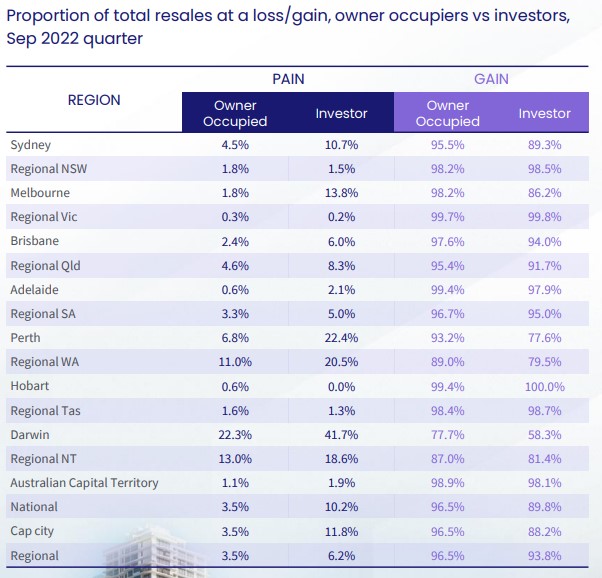
The rate rises and falling home values over the three months in September impacted the profits of many property sellers in capital cities.
CoreLogic’s latest Pain and Gain Report showed that the share of profit-making sales declined to 93.3% during the third quarter of the year, down from the recent high of 94.2% over the three-month period to May.
CoreLogic head of research Eliza Owens said profitability deteriorated most quickly across the combined capitals as Australian mortgage holders face a challenging period.
“A rise in interest rates creates a double whammy for homeowners, in that the cost of debt becomes harder to service, and the underlying asset value against which the debt is held declines,” she said.
Over the period, the Reserve Bank of Australia made 150bps increase in the cash rate on top of the 75bps increases in May and June.
The cash rate was 2.35% in September. The RBA, then, slowed down the pace of hikes, rolling out three consecutive months of 25bps increases which brings the cash rate to its current level at 3.10%.
Ms Owen said one key question about resales data will be whether more recent buyers are selling at a loss in the current climate.
“This would indicate a greater level of risk in the housing market, as more ‘distressed’ or ‘motivated’ sales would create a rise in listings volumes, and put further downward pressure on prices,” she said.
In fact, the combined value of loss-making sales rose 3.2%, to $308m — the median loss was $40,000, higher than the $33,500 during the quarter.
Meanwhile, the combined value of nominal gains from resale over the three months was $26.1bn, down from a revised $30.4bn in the June quarter.
The higher volume of loss-making sales occurred in areas where there had been less growth in value over a long period, such as resource-based markets and high-density investment markets.
For instance, Perth accounted for around 21% of loss-making resales in the quarter. Of these resales in Perth, the median hold period was 8.8 years. This indicates voluntary decision for the sale to incur a loss, rather than being in a distressed position.
“Markets that have seen a sharper capital growth decline in recent months, such as the house segment, or popular lifestyle markets, still have a relatively low incidence of loss-making sales,” Ms Owen said.
Ms Owen said there are no material increase in distressed sales during the quarter, despite the increase in loss-making sales.
“While it’s true the recent decline in home values increases the chances of vendors selling at a loss, even properties held for less than two years had a median resale gain of $121,00 in the quarter.”
The rate of decline in profit-making sales coincided with the recent drop in home values, which went down 4.8% in September from its peak in April 2022.
Interestingly, while house values declined faster than units in September, units witnessed a faster deterioration in profit-making sales.
The highest portion of loss-making unit resales was across a smaller pool of sales in Darwin, where 48.2% of unit resales made a nominal loss.
Ms Owen said the resales market is likely to be challenged in 2023, as more outstanding fixed loan terms expire.
This could force many property owners to sell as they navigate a higher-interest-rate environment, even if they endure a loss.
“With home values generally still above pre-pandemic levels, there is likely to be a ceiling on the rate of loss-making sales observed in the coming quarters,” Ms Owen said.
“The fluctuation in the rate of loss-making sales is not expected to be as severe as the overall decline in property values — the rate of loss-making sales has not spiked as dramatically as values have fallen, because losses are only realised if a property owner chooses, or is forced, to sell.”

-
Photo by Kindel Media on Pexels.